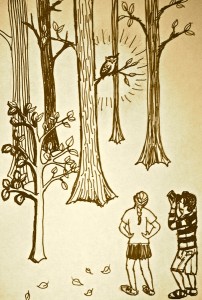In Pilgrim at Tinker Creek, Annie Dillard talks a lot about seeing. She explains how in order to truly see something, she must first bring attention to it. Seeing is not just about the eyes and what happens before them, but the mental awareness that the observer has. Dillard defines two types of seeing: the first kind requires one to “analyze and pry” while the second kind involves “a letting go.” She compares these two types of seeing to “walking with and without a camera.”
My drawing demonstrates these two types of seeing. When we went to Congaree National Park, I remember my eyes wandering through the woods when suddenly…I saw a GIANT OWL! I was very exciting and proud. I felt as though the owl was mine because I discovered it. So in the drawing, I am the curious and camera-less observer striking a sassy pose with my arms akimbo.
The camera-bearing observer is Kenta. I feel like Kenta is the kind of person who walks around with his camera trying to find something visually appealing that would make a good photographic composition (Yes, I am obsessed with Kenta; however, this part of Pilgrim was relevant and reminded me of him). While Kenta carefully seeks out an image, I just try to see as much as I can and try to think about the meaning of it all.
After claiming bragging rights for spotting the mystic owl, I thought about its meaning in nature. I thought about how owls are always in isolation, how they’re so different from other birds, and that they are nocturnal. I thought “How different is this creature from us? It lives alone, sleeps all day, and always looks angry. Maybe owls aren’t that different from some of us.” I really wanted it to spin its head all the way around, but that was just wishful thinking.
-Grace Gibson

